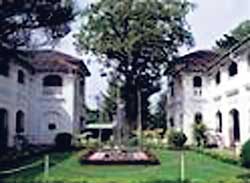Rubber becomes a major export product
We have always talked about the three major export products of Sri Lanka – tea, rubber and coconut. The dawn of the 20th century saw rubber (Hevea brasiliensis) making an impact as a leading export product. By 1910 rubber overtook coconut to become the second largest export after tea. The quantity of rubber being traded and exported had expanded so much that the trade decided to have a weekly rubber auction. The first rubber auction was held on November 4, 1910.
 |
The story of rubber as a commodity is a fascinating one. A Chamber of Commerce publication capsules how it became a raw material from a plaything. "Rubber, used in South America to make play balls, was brought back to Europe by European explorers as an oddity. Scientific curiosity transformed it into a valuable raw material after Charles Mackintosh's work on the rubberizing of fabrics, the innovation of vulcanization by Thomas Hancock in England and Charles Goodyear in America, and the invention of the first practical pneumatic tyre by Irishman John Dunlop.
The invention of the motor car changed the plaything of South America into a prime raw material for industry. "(As you know Goodyear and Dunlop are popular brand names of tyres to this day).
With the new uses being identified for rubber, the search began for sources of supply. They could not depend purely on South America to get their requirements. It is recorded that the British botanist Sir Henry Wickham smuggled 70,000 seeds out of Brazil's Amazon valley for planting in the Royal Botanical Gardens in Kew, in England.
The seeds were successfully cultivated and one thousand nine hundred and nineteen seeds were shipped to Sri Lanka in 1876. These were planted at the Henarathgoda Botanical Gardens near Gampaha and the original trees can still be seen there.
There was little interest in growing rubber in the initial years thus making the progress rather slow. The change came with the new wave of industrialisation in Europe. When rubber became an attractive commodity with the development of the automobile industry, the interest took a dramatic turn.
From a mere 700 hectares in 1900 the extent of rubber shot up to 60,000 hectares by 1907. Kalutara and other low-lying districts were the areas where rubber was grown extensively. The districts of Kegalle, Kalutara, Ratnapura, Galle and Colombo cover over two-thirds of the planted area. The remainder are in the Matara, Gampaha, Kurunegala, Matale and Kandy districts.
Rubber production was aimed at the export market from inception. By 1913, three years after the auctions were started rubber emerged as the major foreign exchange earner next to tea.
The Sri Lankan rubber industry is dominated by private smallholders who produce more than two thirds of the total output. The national rubber production for the year 2006 was 109,153 metric tons, which was a 4.4 per cent increase with the previous year. The total earning of rubber products exports is Rs.40 billion. It is estimated that rubber production this year would be around 112,000 metric tons.
|


